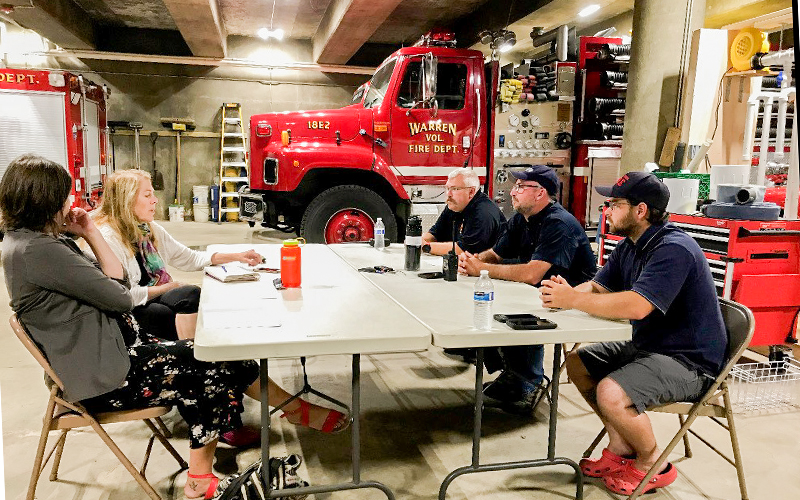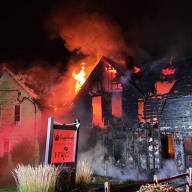This is the second part of The Valley Reporter’s conversation with Warren Volunteer Fire Department chief Jeff Campbell, Waitsfield-Fayston Volunteer Fire Department chief Tripp Johnson and Moretown Volunteer Fire Department chief Stefan Pratt. The series will continue next week.
The Waitsfield-Fayston Fire Department currently has 24 volunteers, while Moretown has 15 and Warren has 24 or 25. The Warren Fire Department received 92 calls last year and this year has received 87 calls before the end of August. When asked what accounts for the increase in calls, Campbell said, “I think it’s the population growth, or second-home owners who are making this their primary home. We’re probably going to see at least 25% growth.” Waitsfield typically gets 110-120 calls and Johnson said the department is on pace to have a typical year. Pratt said Moretown typically gets 30-50 calls in a year.
In terms of what causes these fires, “A lot of it is woodstove-related,” Johnson said, “electrical, basic upkeep or neglect of upkeep of infrastructure in people’s houses.”
“During COVID people were selling their houses and now there’s new people coming in who don’t know any of the Vermont quirks this house had,” Pratt said. “They don’t know that the wiring to the garage is smaller than it probably should be.”
“And then they plug the power strip into the power strip into the wall,” Campbell added.
CARCINOGENS
Building materials have also changed. “Back in the day in the 1970s there was old, hard timber,” Johnson said. “Everything was not synthetic, wasn’t oil-based. Nowadays firefighting’s changed a lot with how the fire behaves, the danger to us, how we’ve been educated to fight fires. The biggest threat nowadays to a fireman is it’s a 57% cancer rate. With the newer generation of fireman, that’s what they really care about. That’s what we’re all focusing on these days. The fires from when Paul [Hartshorn] and Gordie [Eurich] started didn’t have the toxicity. We’ve purchased an extractor and we’re in the mix of getting that set up.”
“It extracts all the carcinogens from the gear,” Campbell added.
There are two parts to the jackets firefighters wear -- an outer layer that protects from cuts and abrasions and an interior thermal layer. Both can absorb carcinogens and need to be washed separately. The extraction and drying process takes 10-plus hours. Two sets are able to fit in the machine at a time.
“Jeff [Campbell] has been very, very helpful with letting us use his extractor,” Johnson said. “But the thing is, the last fire we had, Jeff had I believe 16 members there. I had 16 or 18.” Moretown had seven. “Relying on Jeff’s extractor, it puts us out of commission for a long time,” Johnson said.
“The challenge is, you can wash your hoods, you can wash your jackets, you can wash your pants,” Campbell said, but boots typically aren’t washed and can also contain carcinogens. There are out-of-state companies in Connecticut and Massachusetts that can professionally wash firefighting gear, including helmets and boots, which the local chiefs are interested in talking to their select boards about. “We’re taking a look at having this company come up and having [the gear] professionally cleaned and inspected,” Johnson said. He said firefighting gear needs to be replaced every 10 years, whether it’s been used or not.
FIREFIGHTER SAFETY
“It’s our jobs as fire chiefs, number one to provide scene safety, and it’s our job to protect our [firefighters] and that’s after the scene, too. With the cancer being so high, this is something that we’re very focused on,” Johnson said. “Protection starts before with the training, then obviously at the fire scene, and then afterwards it’s getting the gear taken care of and everything else.”
They said gear is improving with time, though the cost of upkeep and testing has increased, too. Hoses, air packs and gas meters need to be tested. Johnson said, three years ago air packs were quoted at $5,600; they now cost $7,800. One set of gear costs roughly $3,600, in addition to the price of a radio and air pack. Bottles alone cost $1,600 and need to be replaced every 15 years.
“We’re having [hose tests] done in September,” Campbell said. “We’ll also get our ladders tested. That will end up costing us right around $7,000.”
“Mine went up $600 this year,” Johnson said. Pratt said he’s working on getting hose testing done for the first time and working with the Moretown Select Board to determine the cost.
VALUABLE TOOL
When asked about how technology has changed how the departments operate, Johnson said, “The biggest thing that’s changed that I see that’s a very, very valuable tool is our thermal imaging camera. It’s a tool to let us know how to attack the fire. It’s a tool that lets us know if somebody’s trapped; it gives off their body heat. That’s the most valuable tool in my eyes in the last 15 years.
“The newer construction is a challenge for us. The electric vehicles are a challenge for us. We had a car fire up on the top of Route 17 -- multiple cars -- but you weren’t putting that out with the magnesium metals and stuff like that, that just wasn’t happening. There’s those challenges.”
Warren fire chief Jeff Campbell added, “The technology that’s allowed people to figure out better tactics. In the past you’d want to break a window, now it’s the last thing you’d do. You want to trap the amount of air that gets into the building because the more air you give it, the more it’s going to feed. Technology and different studies have improved how we do things. Now what might have been an entire house fire can be contained to one room.”












